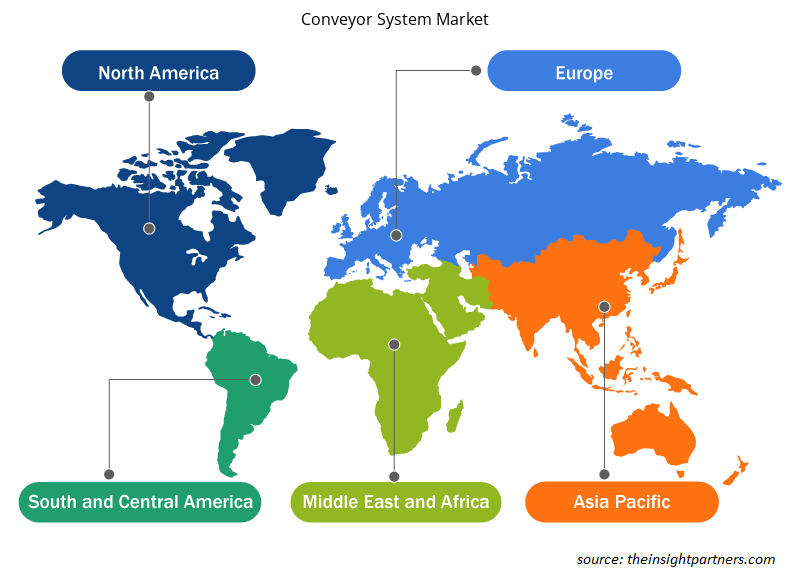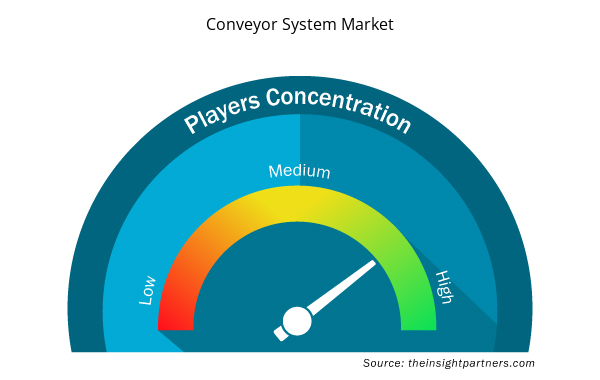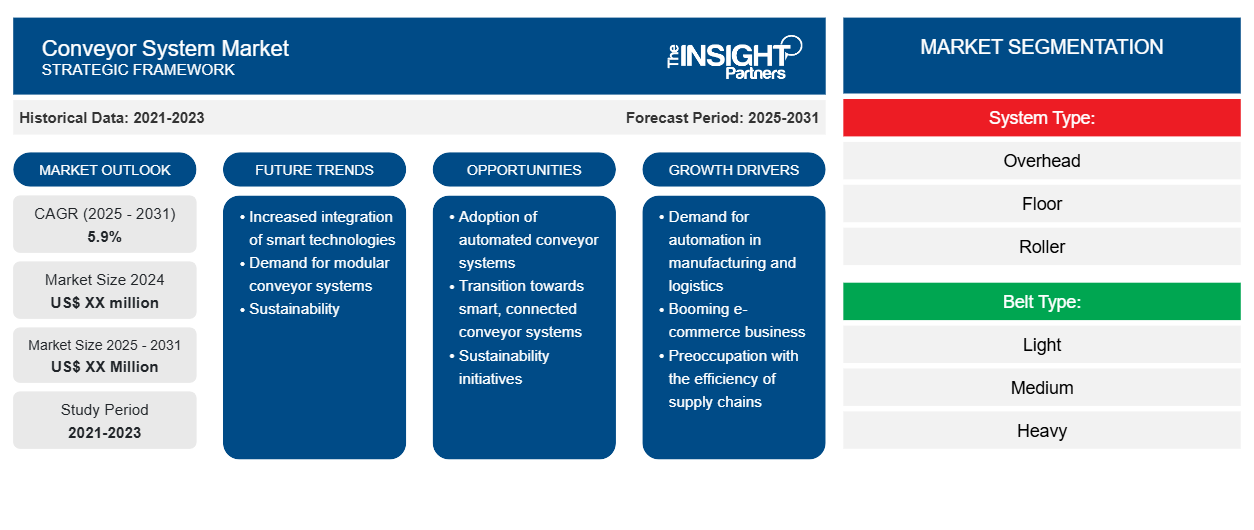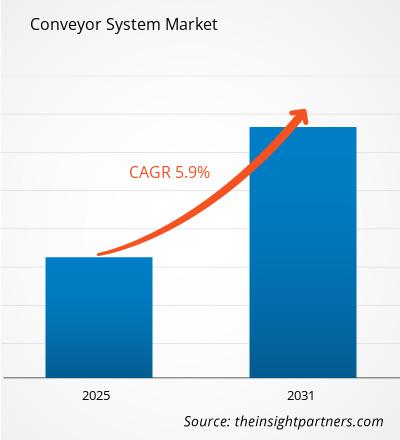Se espera que el mercado de sistemas transportadores registre una CAGR del 5,9 % entre 2024 y 2031, con un tamaño de mercado que se expandirá de US$ XX millones en 2024 a US$ XX millones en 2031.
Este informe de investigación sobre el mercado de sistemas de transporte incluye análisis en profundidad del estado y las perspectivas de esta importante industria, destacando las tendencias y oportunidades que impulsarían a los segmentos del mercado hacia adelante. El informe clasifica el mercado por tipo de sistema, tipo de correa e industria del usuario final, lo que proporciona una visión profunda sobre la variabilidad del mercado, las preferencias de los consumidores y los patrones de consumo en varios sectores.
Este estudio analiza la tendencia de la automatización en la fabricación y la logística que define la demanda de sistemas de transporte, que mejoran la eficiencia y la productividad de las operaciones. Estudia varios tipos de transportadores, incluidos los sistemas de correa, rodillos y modulares aplicados en industrias diversificadas como la automotriz, la alimentación y las bebidas, el almacenamiento y la distribución.
Además, la segmentación incluye información sobre las industrias por usuarios finales, lo que describe cómo los requisitos diversificados moldean la adopción de soluciones de transporte. Además, el documento investiga los canales de venta que cubren las ventas directas, los distribuidores y las plataformas de comercio electrónico que revelarían estrategias efectivas para la penetración en el mercado y la participación del cliente.
Propósito del Informe
El informe Conveyor System Market de The Insight Partners tiene como objetivo describir el panorama actual y el crecimiento futuro, los principales factores impulsores, los desafíos y las oportunidades. Esto proporcionará información a diversas partes interesadas del negocio, como:
- Proveedores/fabricantes de tecnología: Para comprender la dinámica cambiante del mercado y conocer las oportunidades potenciales de crecimiento, lo que les permitirá tomar decisiones estratégicas informadas.
- Inversionistas: Realizar un análisis exhaustivo de tendencias sobre la tasa de crecimiento del mercado, las proyecciones financieras del mercado y las oportunidades que existen en toda la cadena de valor.
- Órganos reguladores: Regular las políticas y vigilar las actividades del mercado con el objetivo de minimizar los abusos, preservar la confianza de los inversores y defender la integridad y la estabilidad del mercado.
Segmentación del mercado de sistemas transportadores
Tipo de sistema:
- Arriba
- Piso
- Rodillo
- Cinturón
- Otros
Tipo de cinturón:
- Luz
- Medio
- Pesado
Industria:
- Alimentos y bebidas
- Automotor
- Aeropuertos
- Logística
- Metales y minería
- Otros
Geografía
- América del norte
- Europa
- Asia-Pacífico
- América del Sur y Central
- Oriente Medio y África
Personalice este informe según sus necesidades
Obtendrá personalización en cualquier informe, sin cargo, incluidas partes de este informe o análisis a nivel de país, paquete de datos de Excel, así como también grandes ofertas y descuentos para empresas emergentes y universidades.
- Obtenga las principales tendencias clave del mercado de este informe.Esta muestra GRATUITA incluirá análisis de datos, desde tendencias del mercado hasta estimaciones y pronósticos.
Factores impulsores del crecimiento del mercado de sistemas transportadores
- Demanda de automatización en la fabricación y la logística: Existe una creciente demanda de automatización en la fabricación y la logística. Los sistemas de transporte automatizados se han convertido en aspectos imperativos en los esfuerzos de las empresas por aumentar su eficiencia operativa y reducir los costos laborales. Este aspecto se puede ver más claramente en industrias como la automotriz, la de alimentos y bebidas y la farmacéutica, donde los procesos optimizados son cruciales.
- Auge del comercio electrónico: El crecimiento de las compras online ha hecho que las empresas inviertan mucho en la automatización de los almacenes como forma de mantener el control de los volúmenes de pedidos que han ido creciendo, al tiempo que se cumplen las expectativas de unos plazos de entrega más largos. En este sentido, los sistemas de transporte forman parte del núcleo mismo de la cadena logística, permitiendo a las empresas clasificar los pedidos con mucha más rapidez y precisión para poder seguir el ritmo de la satisfacción del consumidor en un entorno de dura competencia.
- Preocupación por la eficiencia de las cadenas de suministro: La preocupación por la eficiencia de las cadenas de suministro contribuye a la adopción generalizada de sistemas de transporte. El crecimiento constante de la demanda de los consumidores ha hecho que las industrias se den cuenta de que tienen que trabajar para agilizar los flujos de trabajo de producción. Por lo tanto, las empresas están en condiciones de mejorar su manipulación de materiales, reducir los cuellos de botella operativos y aumentar la productividad con el uso de soluciones de transporte.
- Tecnologías avanzadas: Los avances tecnológicos fomentan un mayor crecimiento del mercado. Las tecnologías inteligentes se integran en los procesos de IoT e IA para el monitoreo en tiempo real de los sistemas de transporte y el mantenimiento predictivo. También mejoran la operatividad para reducir los tiempos de inactividad y permiten operaciones comerciales fluidas y efectivas.
Tendencias futuras del mercado de sistemas transportadores
- Mayor integración de tecnologías inteligentes: Tecnologías como IoT e IA constituyen probablemente una de las tendencias más activas en los últimos años. Todas ellas permiten la monitorización en tiempo real, el mantenimiento predictivo y las mejoras en la eficiencia operativa que permitirán a las empresas lograr la optimización de procesos con menos tiempos de inactividad.
- Demanda de sistemas de transporte modulares: estos sistemas de transporte modulares facilitan la flexibilidad y la escalabilidad, lo que permite a las empresas adaptarse fácil y rápidamente a los cambios en las necesidades de producción y escalar sus operaciones sin recurrir a grandes renovaciones. Por lo tanto, esta escalabilidad es especialmente bien recibida en sectores como el comercio electrónico y la fabricación, donde los requisitos pueden fluctuar en cualquier momento.
- Sostenibilidad: La sostenibilidad también resulta ser un tema crítico; cada vez más empresas buscan soluciones de transporte energéticamente eficientes. Los fabricantes están desarrollando diseños ecológicos que reducirán el consumo de energía y las emisiones de carbono, coincidiendo así con los objetivos de sostenibilidad corporativa más amplios.
Oportunidades de mercado en sistemas transportadores
- Adopción de sistemas de transporte automatizados: las empresas intentan aumentar la eficiencia y minimizar los costos operativos. Esto se hace particularmente evidente en áreas como el comercio electrónico y la fabricación, donde la necesidad de cumplir con los pedidos es muy rápida y los procesos deben ser lo más fluidos posible. Con una proyección de que las ventas del comercio electrónico superarán los 6 billones de dólares para 2024, la necesidad de medios eficientes de soluciones de manipulación de materiales no puede ser más fuerte.
- Transición hacia sistemas de transporte inteligentes y conectados: con tecnologías integradas como el Internet de las cosas y la inteligencia artificial que permitirán la monitorización en tiempo real y el mantenimiento predictivo, esto puede mejorar drásticamente la eficiencia operativa de las empresas y reducir sus niveles de tiempo de inactividad. Se espera que el mercado del IoT en sistemas de transporte crezca a un ritmo sustancial, una característica que refleja un fuerte interés de los inversores en estas innovaciones.
- Iniciativas de sostenibilidad: Dado que las industrias se centran cada vez más en reducir su huella ambiental, las soluciones de transporte energéticamente eficientes han empezado a ganar importancia. Los sistemas ecológicos que ahorran el consumo de energía se traducen en enormes ahorros de costes y estas soluciones resultan atractivas para las empresas que buscan mejorar sus perfiles de sostenibilidad.
Perspectivas regionales del mercado de sistemas transportadores
Los analistas de Insight Partners explicaron en detalle las tendencias y los factores regionales que influyen en el mercado de sistemas de transporte durante el período de pronóstico. Esta sección también analiza los segmentos y la geografía del mercado de sistemas de transporte en América del Norte, Europa, Asia Pacífico, Oriente Medio y África, y América del Sur y Central.

- Obtenga datos regionales específicos para el mercado de sistemas transportadores
Alcance del informe de mercado de sistemas transportadores
| Atributo del informe | Detalles |
|---|---|
| Tamaño del mercado en 2024 | XX millones de dólares estadounidenses |
| Tamaño del mercado en 2031 | US$ XX millones |
| Tasa de crecimiento anual compuesta (CAGR) global (2025-2031) | 5,9% |
| Datos históricos | 2021-2023 |
| Período de pronóstico | 2025-2031 |
| Segmentos cubiertos | Por tipo de sistema:
|
| Regiones y países cubiertos | América del norte
|
| Líderes del mercado y perfiles de empresas clave |
|
Densidad de actores del mercado de sistemas transportadores: comprensión de su impacto en la dinámica empresarial
El mercado de sistemas de transporte está creciendo rápidamente, impulsado por la creciente demanda de los usuarios finales debido a factores como la evolución de las preferencias de los consumidores, los avances tecnológicos y una mayor conciencia de los beneficios del producto. A medida que aumenta la demanda, las empresas amplían sus ofertas, innovan para satisfacer las necesidades de los consumidores y aprovechan las tendencias emergentes, lo que impulsa aún más el crecimiento del mercado.
La densidad de actores del mercado se refiere a la distribución de las empresas o firmas que operan dentro de un mercado o industria en particular. Indica cuántos competidores (actores del mercado) están presentes en un espacio de mercado determinado en relación con su tamaño o valor total de mercado.
Las principales empresas que operan en el mercado de sistemas transportadores son:
- Compañía Daifuku Co., Ltd.
- Demático
- Compañía Eléctrica Emerson
- Honeywell Intelligrated
- Interroll Holding GmbH
Descargo de responsabilidad : Las empresas enumeradas anteriormente no están clasificadas en ningún orden particular.

- Obtenga una descripción general de los principales actores clave del mercado de sistemas transportadores
Puntos de venta clave
- Cobertura integral: el informe cubre de manera integral el análisis de productos, servicios, tipos y usuarios finales del mercado de sistemas transportadores, proporcionando un panorama holístico.
- Análisis de expertos: el informe se compila sobre la base de un profundo conocimiento de expertos y analistas de la industria.
- Información actualizada: El informe asegura relevancia comercial debido a su cobertura de información reciente y tendencias de datos.
- Opciones de personalización: este informe se puede personalizar para satisfacer los requisitos específicos del cliente y adaptarse adecuadamente a las estrategias comerciales.
Por lo tanto, el informe de investigación sobre el mercado de sistemas de transporte puede ayudar a abrir camino para descifrar y comprender el escenario de la industria y las perspectivas de crecimiento. Si bien puede haber algunas preocupaciones válidas, los beneficios generales de este informe tienden a superar las desventajas.
- Análisis histórico (2 años), año base, pronóstico (7 años) con CAGR
- Análisis PEST y FODA
- Tamaño del mercado Valor/volumen: global, regional, nacional
- Industria y panorama competitivo
- Conjunto de datos de Excel


- Micro-Surgical Robot Market
- Smart Locks Market
- Vision Guided Robotics Software Market
- Hydrolyzed Collagen Market
- Photo Printing Market
- Public Key Infrastructure Market
- Sweet Potato Market
- Energy Recovery Ventilator Market
- Water Pipeline Leak Detection System Market
- Lyophilization Services for Biopharmaceuticals Market

Report Coverage
Revenue forecast, Company Analysis, Industry landscape, Growth factors, and Trends

Segment Covered
This text is related
to segments covered.

Regional Scope
North America, Europe, Asia Pacific, Middle East & Africa, South & Central America

Country Scope
This text is related
to country scope.
Preguntas frecuentes
The report can be delivered in PDF/PPT format; we can also share excel dataset based on the request.
Some of the customization options available based on request are additional 3-5 company profiles and country-specific analysis of 3-5 countries of your choice. Customizations are to be requested/discussed before making final order confirmation, as our team would review the same and check the feasibility.
The market is expected to register a CAGR of 5.9% during 2023-2031
In a nutshell, the driving forces of the Conveyor System Market include demand from automation, growth in e-commerce, efficiency in supply chains, technological advancement, and environmental concerns. These factors together create a dynamic landscape that positions the market for continued growth in the coming years.
Increased automation of warehouses and distribution centers, therefore, drives investment in advanced conveyor technologies. Also, automated systems will be unavoidable to handle the increased volume of orders and for improving the efficiency of overall logistics. As these trends continue to evolve, the Conveyor System Market is poised for sustained growth, meeting the demands of a rapidly changing industrial landscape.
The key players in conveyor system market are - Daifuku Co Ltd, Dematic, Emerson Electric Co, Honeywell Intelligrated, Interroll Holding GmbH, Siemens AG, SSI Schafer, Swisslog Holding AG, TGW Logistics Group
Trends and growth analysis reports related to Manufacturing and Construction : READ MORE..
The List of Companies - Conveyor System Market
- Daifuku Co., Ltd.
- Dematic
- Emerson Electric Co
- Honeywell Intelligrated
- Interroll Holding GmbH
- Siemens AG
- SSI Schafer
- Swisslog Holding AG
- TGW Logistics Group
- Vanderlande Industries B.V
The Insight Partners performs research in 4 major stages: Data Collection & Secondary Research, Primary Research, Data Analysis and Data Triangulation & Final Review.
- Data Collection and Secondary Research:
As a market research and consulting firm operating from a decade, we have published and advised several client across the globe. First step for any study will start with an assessment of currently available data and insights from existing reports. Further, historical and current market information is collected from Investor Presentations, Annual Reports, SEC Filings, etc., and other information related to company’s performance and market positioning are gathered from Paid Databases (Factiva, Hoovers, and Reuters) and various other publications available in public domain.
Several associations trade associates, technical forums, institutes, societies and organization are accessed to gain technical as well as market related insights through their publications such as research papers, blogs and press releases related to the studies are referred to get cues about the market. Further, white papers, journals, magazines, and other news articles published in last 3 years are scrutinized and analyzed to understand the current market trends.
- Primary Research:
The primarily interview analysis comprise of data obtained from industry participants interview and answers to survey questions gathered by in-house primary team.
For primary research, interviews are conducted with industry experts/CEOs/Marketing Managers/VPs/Subject Matter Experts from both demand and supply side to get a 360-degree view of the market. The primary team conducts several interviews based on the complexity of the markets to understand the various market trends and dynamics which makes research more credible and precise.
A typical research interview fulfils the following functions:
- Provides first-hand information on the market size, market trends, growth trends, competitive landscape, and outlook
- Validates and strengthens in-house secondary research findings
- Develops the analysis team’s expertise and market understanding
Primary research involves email interactions and telephone interviews for each market, category, segment, and sub-segment across geographies. The participants who typically take part in such a process include, but are not limited to:
- Industry participants: VPs, business development managers, market intelligence managers and national sales managers
- Outside experts: Valuation experts, research analysts and key opinion leaders specializing in the electronics and semiconductor industry.
Below is the breakup of our primary respondents by company, designation, and region:

Once we receive the confirmation from primary research sources or primary respondents, we finalize the base year market estimation and forecast the data as per the macroeconomic and microeconomic factors assessed during data collection.
- Data Analysis:
Once data is validated through both secondary as well as primary respondents, we finalize the market estimations by hypothesis formulation and factor analysis at regional and country level.
- Macro-Economic Factor Analysis:
We analyse macroeconomic indicators such the gross domestic product (GDP), increase in the demand for goods and services across industries, technological advancement, regional economic growth, governmental policies, the influence of COVID-19, PEST analysis, and other aspects. This analysis aids in setting benchmarks for various nations/regions and approximating market splits. Additionally, the general trend of the aforementioned components aid in determining the market's development possibilities.
- Country Level Data:
Various factors that are especially aligned to the country are taken into account to determine the market size for a certain area and country, including the presence of vendors, such as headquarters and offices, the country's GDP, demand patterns, and industry growth. To comprehend the market dynamics for the nation, a number of growth variables, inhibitors, application areas, and current market trends are researched. The aforementioned elements aid in determining the country's overall market's growth potential.
- Company Profile:
The “Table of Contents” is formulated by listing and analyzing more than 25 - 30 companies operating in the market ecosystem across geographies. However, we profile only 10 companies as a standard practice in our syndicate reports. These 10 companies comprise leading, emerging, and regional players. Nonetheless, our analysis is not restricted to the 10 listed companies, we also analyze other companies present in the market to develop a holistic view and understand the prevailing trends. The “Company Profiles” section in the report covers key facts, business description, products & services, financial information, SWOT analysis, and key developments. The financial information presented is extracted from the annual reports and official documents of the publicly listed companies. Upon collecting the information for the sections of respective companies, we verify them via various primary sources and then compile the data in respective company profiles. The company level information helps us in deriving the base number as well as in forecasting the market size.
- Developing Base Number:
Aggregation of sales statistics (2020-2022) and macro-economic factor, and other secondary and primary research insights are utilized to arrive at base number and related market shares for 2022. The data gaps are identified in this step and relevant market data is analyzed, collected from paid primary interviews or databases. On finalizing the base year market size, forecasts are developed on the basis of macro-economic, industry and market growth factors and company level analysis.
- Data Triangulation and Final Review:
The market findings and base year market size calculations are validated from supply as well as demand side. Demand side validations are based on macro-economic factor analysis and benchmarks for respective regions and countries. In case of supply side validations, revenues of major companies are estimated (in case not available) based on industry benchmark, approximate number of employees, product portfolio, and primary interviews revenues are gathered. Further revenue from target product/service segment is assessed to avoid overshooting of market statistics. In case of heavy deviations between supply and demand side values, all thes steps are repeated to achieve synchronization.
We follow an iterative model, wherein we share our research findings with Subject Matter Experts (SME’s) and Key Opinion Leaders (KOLs) until consensus view of the market is not formulated – this model negates any drastic deviation in the opinions of experts. Only validated and universally acceptable research findings are quoted in our reports.
We have important check points that we use to validate our research findings – which we call – data triangulation, where we validate the information, we generate from secondary sources with primary interviews and then we re-validate with our internal data bases and Subject matter experts. This comprehensive model enables us to deliver high quality, reliable data in shortest possible time.


 Obtenga una muestra gratuita de este informe
Obtenga una muestra gratuita de este informe